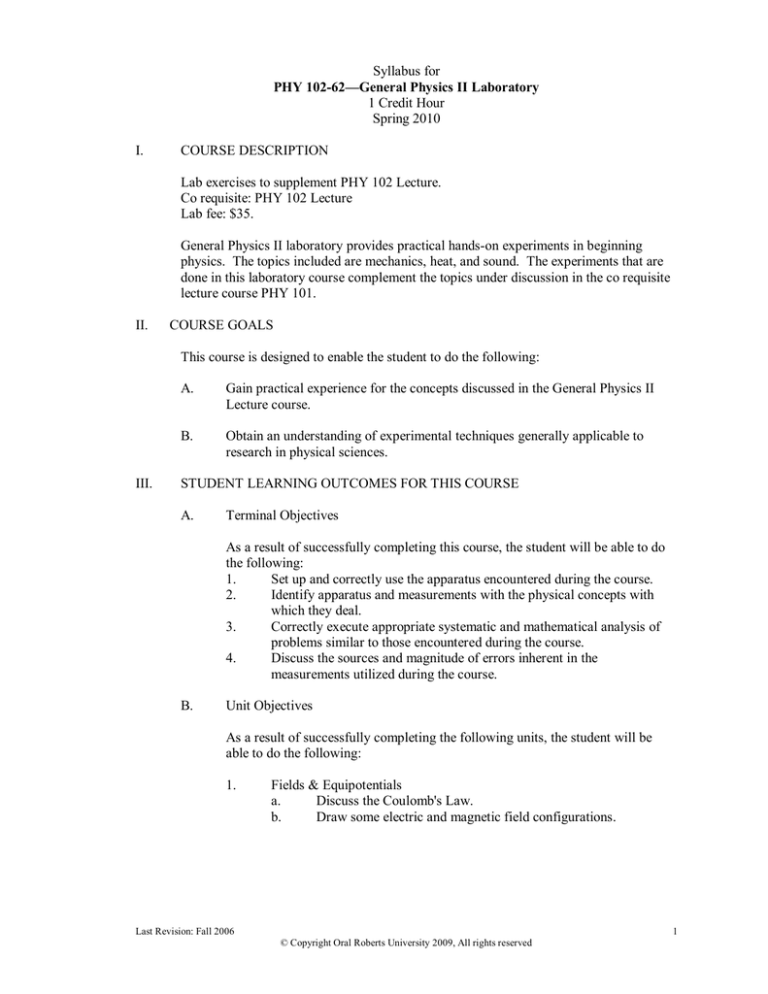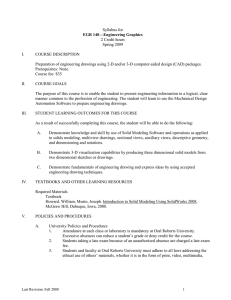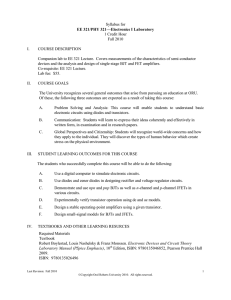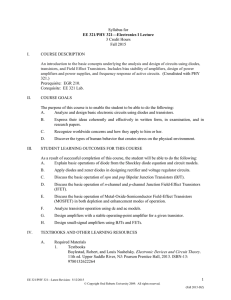
Syllabus for
PHY 102-62—General Physics II Laboratory
1 Credit Hour
Spring 2010
I.
COURSE DESCRIPTION
Lab exercises to supplement PHY 102 Lecture.
Co requisite: PHY 102 Lecture
Lab fee: $35.
General Physics II laboratory provides practical hands-on experiments in beginning
physics. The topics included are mechanics, heat, and sound. The experiments that are
done in this laboratory course complement the topics under discussion in the co requisite
lecture course PHY 101.
II.
COURSE GOALS
This course is designed to enable the student to do the following:
III.
A.
Gain practical experience for the concepts discussed in the General Physics II
Lecture course.
B.
Obtain an understanding of experimental techniques generally applicable to
research in physical sciences.
STUDENT LEARNING OUTCOMES FOR THIS COURSE
A.
Terminal Objectives
As a result of successfully completing this course, the student will be able to do
the following:
1.
Set up and correctly use the apparatus encountered during the course.
2.
Identify apparatus and measurements with the physical concepts with
which they deal.
3.
Correctly execute appropriate systematic and mathematical analysis of
problems similar to those encountered during the course.
4.
Discuss the sources and magnitude of errors inherent in the
measurements utilized during the course.
B.
Unit Objectives
As a result of successfully completing the following units, the student will be
able to do the following:
1.
Fields & Equipotentials
a.
Discuss the Coulomb's Law.
b.
Draw some electric and magnetic field configurations.
Last Revision: Fall 2006
1
© Copyright Oral Roberts University 2009, All rights reserved
2.
3.
4.
5.
6.
7.
8.
9.
10.
11.
12.
IV.
V.
Resistances in Series & Parallel
a.
Draw the circuit characteristics of resistors in series and parallel.
b.
Measure the current, voltage, and resistance in both circuits.
The Measurement of Resistance: Wheatstone bridge
a.
Operate a slide-wire Wheatstone bridge.
b.
Measure an unknown resistance using a Wheatstone bridge.
The Potentiometer
a.
Operate the potentiometer.
b.
Measure resistance’s accurately using the potentiometer
Joule's Law
a.
Measure the joule equivalent of the calorie of heat energy.
b.
Measure electric heating.
The RC Circuit
a.
Construct an RC circuit.
b.
Measure the time constant of an RC circuit.
Electromagnetic Induction
a.
Measure the amount, direction, and duration of an induced
current.
b.
Construct a transformer.
Reflection and Refraction
a.
Discuss the laws of reflection.
b.
Discuss the laws of refraction.
Spherical Mirrors and Lenses
a.
Measure the focal length of several lenses and mirrors.
b.
Explain the parameters that govern the use of spherical mirrors
and lenses.
Optic of the Eye
a.
Explain the eye is an optical instrument.
b.
Explain how lenses are used to correct visual defects.
The Transmission Diffraction Grating: Spectrometer Method
a.
Use a spectrometer.
b.
Discuss the optical spectra.
Detection of Nuclear Radiation
a.
Explain the characteristics of the Geiger tube.
b.
Explain the inverse-square relationship for nuclear radiation.
TEXTBOOKS AND OTHER LEARNING RESOURCES
A.
Required Materials
Textbook
Wilson, Jerry D. Physics Laboratory Experiments, 7th ed. Boston: Houghton
Mifflin Company, 2010.
Other
Scientific Calculator
B.
Optional Materials
None
POLICIES AND PROCEDURES
A.
University Policies and Procedures
1.
Attendance at each class or laboratory is mandatory at Oral Roberts
University. Excessive absences can reduce a student’s grade or deny
credit for the course.
2
© Copyright Oral Roberts University 2009, All rights reserved
2.
3.
4.
5.
B.
Students taking a late exam because of an unauthorized absence are
charged a late exam fee.
Students and faculty at Oral Roberts University must adhere to all laws
addressing the ethical use of others’ materials, whether it is in the form
of print, video, multimedia, or computer software. By submitting an
assignment in any form, the student gives permission for the assignment
to be checked for plagiarism, either by submitting the work for electronic
verification or by other means.
Final exams cannot be given before their scheduled times. Students need
to check the final exam schedule before planning return flights or other
events at the end of the semester.
Students are to be in compliance with University, school, and
departmental policies regarding Whole Person Assessment (WPA)
requirements. Students should consult the WPA handbooks for
requirements regarding general education and the students’ majors.
a.
The penalty for not submitting electronically or for incorrectly
submitting an ePortfolio artifact is a zero for that assignment.
b.
By submitting an assignment, the student gives permission for
the assignment to be assessed electronically.
Course Policies and Procedures
1.
Evaluation Procedures
a.
The laboratory manual for this course contains procedural
instructions, theoretical explanations, and relevant questions for
each experiment. Results from the procedures and answers to the
questions will be written in the designated areas within the
manual. Then a discussion or conclusion of the experiment
should be written on a separate sheet of paper and attached to the
report. The conclusion should be concise and to the point, not
over half a page.
b.
Students will have three hours in the laboratory to complete each
day’s experiment, and must hand in their written report at the
end of the period, whenever possible.
c.
Each student is expected to read the experiment before the lab
period and complete the Advance Study Assignment that
precedes each experiment which will be collected at the
beginning of the laboratory period.
d.
12 lab write-ups (25 pts. Each)
=
300 pts
lab final (written and/or practical)
=
150 pts.
3 quizzes (50 pts. Each)
=
150 pts.
____________________________________________________
100%
Total
=
600 pts.
The letter grade is assigned in accordance with the following
percentage ranges:
A
= 100 - 90
B
= 89 - 80
C
= 79 – 70
D
= 69 - 60
F
= 59- 0
3
© Copyright Oral Roberts University 2009, All rights reserved
2.
3.
Whole Person Assessment Requirements
a.
In conjunction with laboratory #6, RC time constant, a special
assessment of the results of the exercise is required to be
submitted as a part of ePortfolio assignment.
b.
Instructions for completing this assignment will be handed out in
lab. They are also available on the eli website under the category
“ePortfolio” as part of the General Education Handbook.
Other Policies and/or Procedures
a.
Students are responsible for the University materials that they use
during the laboratory period and will be assessed an appropriate
fee for any items that are lost, damaged, or broken.
b.
Students should leave their table and apparatus in good order; i.e.,
weights put away, instruments returned, scrap paper picked up, etc.
4
© Copyright Oral Roberts University 2009, All rights reserved
VI.
COURSE CALENDAR
Lab. No.
Lab
1.
Fields and Equipotentials (Handout)
2.
Resistance’s in Series & Parallel. Experiment 21
3.
The Measurement of Resistance (Wheatstone).Experiment 19
4.
The Potentiometer. Experiment 41 (Handout)
5.
Joule's Law. Experiment 22
Quiz 1 over Labs 1-4
6.
The RC Time Constant. (Handout)
7.
Electromagnetic Induction. Experiment 48 (Handout)
8.
Reflection and Refraction. Experiment 25
Quiz 2 over Labs 5-8
9.
10.
Spherical Mirrors and Lenses. Experiment 26
Optic of the Eye. (Handout)
Spring Break
11.
The Transmission Diffraction Grating Spectrometer Method. Experiment 30
12.
Detection of Nuclear Radiation. Experiment 31
13.
Make-up, Review.
14.
Quiz over Labs 9-12
15.
Final
5
© Copyright Oral Roberts University 2009, All rights reserved
Course Inventory for ORU’s Student Learning Outcomes
PHY 102-62—General Physics II Lab
Spring 2010
This course contributes to the ORU student learning outcomes as indicated below:
Significant Contribution – Addresses the outcome directly and includes targeted assessment.
Moderate Contribution – Addresses the outcome directly or indirectly and includes some assessment.
Minimal Contribution – Addresses the outcome indirectly and includes little or no assessment.
No Contribution – Does not address the outcome.
The Student Learning Glossary at http://ir.oru.edu/doc/glossary.pdf defines each outcome and each of the
proficiencies/capacities.
Significant
Moderate
Minimal
No
OUTCOMES & Proficiencies/Capacities
Contribution Contribution Contribution Contribution
1
1A
1B
1C
1D
2
2A
2B
2C
2D
2E
Outcome #1 – Spiritually Alive
Proficiencies/Capacities
Biblical knowledge
Sensitivity to the Holy Spirit
Evangelistic capability
Ethical behavior
Outcome #2 – Intellectually Alert
Proficiencies/Capacities
Critical thinking
Information literacy
Global & historical perspectives
Aesthetic appreciation
Intellectual creativity
√
√
√
√
√
Outcome #3 – Physically Disciplined
Proficiencies/Capacities
3A Healthy lifestyle
3B Physically disciplined lifestyle
√
√
√
√
3
4
4A
4B
4C
4D
4E
Outcome #4 – Socially Adept
Proficiencies/Capacities
Communication skills
Interpersonal skills
Appreciation of cultural & linguistic differences
Responsible citizenship
Leadership capacity
√
√
√
√
√
√
√
6
© Copyright Oral Roberts University 2009, All rights reserved





